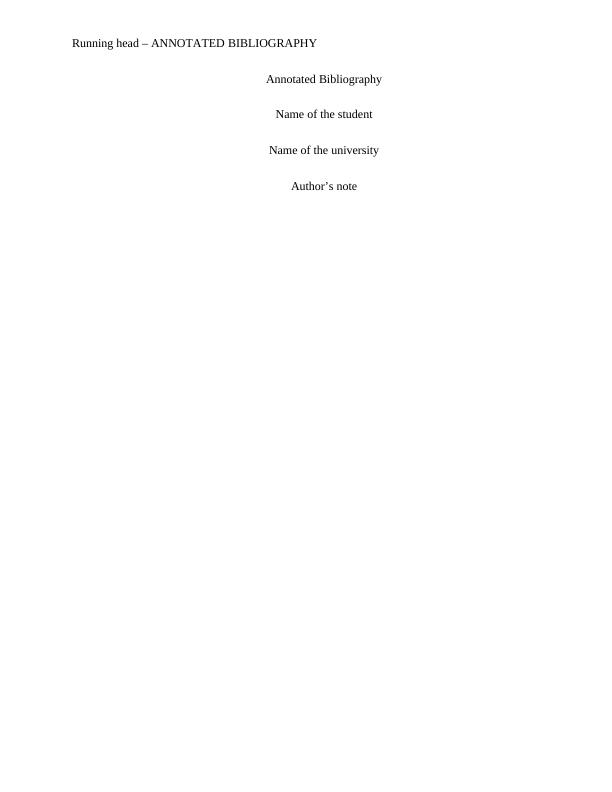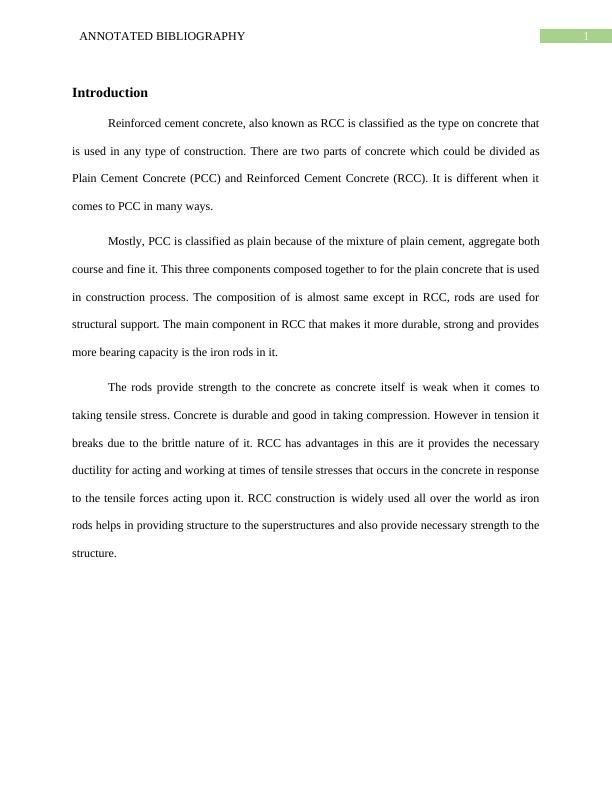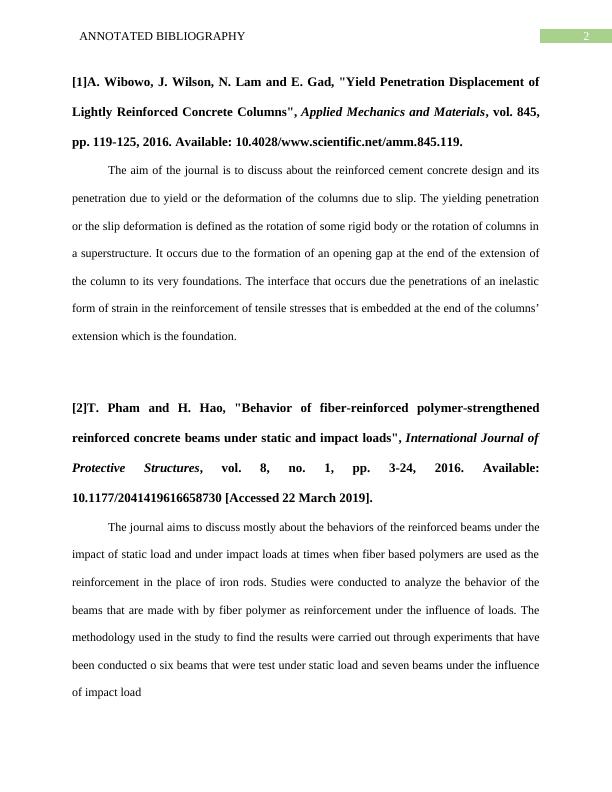Annotated Bibliography on Reinforced Cement Concrete
Added on 2023-04-11
11 Pages1752 Words414 Views
Running head – ANNOTATED BIBLIOGRAPHY
Annotated Bibliography
Name of the student
Name of the university
Author’s note
Annotated Bibliography
Name of the student
Name of the university
Author’s note

1ANNOTATED BIBLIOGRAPHY
Introduction
Reinforced cement concrete, also known as RCC is classified as the type on concrete that
is used in any type of construction. There are two parts of concrete which could be divided as
Plain Cement Concrete (PCC) and Reinforced Cement Concrete (RCC). It is different when it
comes to PCC in many ways.
Mostly, PCC is classified as plain because of the mixture of plain cement, aggregate both
course and fine it. This three components composed together to for the plain concrete that is used
in construction process. The composition of is almost same except in RCC, rods are used for
structural support. The main component in RCC that makes it more durable, strong and provides
more bearing capacity is the iron rods in it.
The rods provide strength to the concrete as concrete itself is weak when it comes to
taking tensile stress. Concrete is durable and good in taking compression. However in tension it
breaks due to the brittle nature of it. RCC has advantages in this are it provides the necessary
ductility for acting and working at times of tensile stresses that occurs in the concrete in response
to the tensile forces acting upon it. RCC construction is widely used all over the world as iron
rods helps in providing structure to the superstructures and also provide necessary strength to the
structure.
Introduction
Reinforced cement concrete, also known as RCC is classified as the type on concrete that
is used in any type of construction. There are two parts of concrete which could be divided as
Plain Cement Concrete (PCC) and Reinforced Cement Concrete (RCC). It is different when it
comes to PCC in many ways.
Mostly, PCC is classified as plain because of the mixture of plain cement, aggregate both
course and fine it. This three components composed together to for the plain concrete that is used
in construction process. The composition of is almost same except in RCC, rods are used for
structural support. The main component in RCC that makes it more durable, strong and provides
more bearing capacity is the iron rods in it.
The rods provide strength to the concrete as concrete itself is weak when it comes to
taking tensile stress. Concrete is durable and good in taking compression. However in tension it
breaks due to the brittle nature of it. RCC has advantages in this are it provides the necessary
ductility for acting and working at times of tensile stresses that occurs in the concrete in response
to the tensile forces acting upon it. RCC construction is widely used all over the world as iron
rods helps in providing structure to the superstructures and also provide necessary strength to the
structure.

2ANNOTATED BIBLIOGRAPHY
[1]A. Wibowo, J. Wilson, N. Lam and E. Gad, "Yield Penetration Displacement of
Lightly Reinforced Concrete Columns", Applied Mechanics and Materials, vol. 845,
pp. 119-125, 2016. Available: 10.4028/www.scientific.net/amm.845.119.
The aim of the journal is to discuss about the reinforced cement concrete design and its
penetration due to yield or the deformation of the columns due to slip. The yielding penetration
or the slip deformation is defined as the rotation of some rigid body or the rotation of columns in
a superstructure. It occurs due to the formation of an opening gap at the end of the extension of
the column to its very foundations. The interface that occurs due the penetrations of an inelastic
form of strain in the reinforcement of tensile stresses that is embedded at the end of the columns’
extension which is the foundation.
[2]T. Pham and H. Hao, "Behavior of fiber-reinforced polymer-strengthened
reinforced concrete beams under static and impact loads", International Journal of
Protective Structures, vol. 8, no. 1, pp. 3-24, 2016. Available:
10.1177/2041419616658730 [Accessed 22 March 2019].
The journal aims to discuss mostly about the behaviors of the reinforced beams under the
impact of static load and under impact loads at times when fiber based polymers are used as the
reinforcement in the place of iron rods. Studies were conducted to analyze the behavior of the
beams that are made with by fiber polymer as reinforcement under the influence of loads. The
methodology used in the study to find the results were carried out through experiments that have
been conducted o six beams that were test under static load and seven beams under the influence
of impact load
[1]A. Wibowo, J. Wilson, N. Lam and E. Gad, "Yield Penetration Displacement of
Lightly Reinforced Concrete Columns", Applied Mechanics and Materials, vol. 845,
pp. 119-125, 2016. Available: 10.4028/www.scientific.net/amm.845.119.
The aim of the journal is to discuss about the reinforced cement concrete design and its
penetration due to yield or the deformation of the columns due to slip. The yielding penetration
or the slip deformation is defined as the rotation of some rigid body or the rotation of columns in
a superstructure. It occurs due to the formation of an opening gap at the end of the extension of
the column to its very foundations. The interface that occurs due the penetrations of an inelastic
form of strain in the reinforcement of tensile stresses that is embedded at the end of the columns’
extension which is the foundation.
[2]T. Pham and H. Hao, "Behavior of fiber-reinforced polymer-strengthened
reinforced concrete beams under static and impact loads", International Journal of
Protective Structures, vol. 8, no. 1, pp. 3-24, 2016. Available:
10.1177/2041419616658730 [Accessed 22 March 2019].
The journal aims to discuss mostly about the behaviors of the reinforced beams under the
impact of static load and under impact loads at times when fiber based polymers are used as the
reinforcement in the place of iron rods. Studies were conducted to analyze the behavior of the
beams that are made with by fiber polymer as reinforcement under the influence of loads. The
methodology used in the study to find the results were carried out through experiments that have
been conducted o six beams that were test under static load and seven beams under the influence
of impact load

3ANNOTATED BIBLIOGRAPHY
[3]"Drift Behaviour of Lightly Reinforced Concrete Columns and Structural Walls
for Seismic Design Applications", Taylor & Francis, 2019. [Online]. Available:
https://www.tandfonline.com/doi/abs/10.7158/13287982.2015.11465179.
The aim of the paper is to find the results that is to be obtained by the investigations of
the lateral drift due the loads and the behavior of the light reinforced cement concrete column
and the structural walls of the superstructure. The walls and the columns are referred as the
common regions that is exposed to the seismic forces and also they are low-moderate in
seismicity. The methodology used in the paper to find the results of the experiments were done
by providing axial loads to the columns and walls to analyze the drift performance available in
the columns that are dominated by compression.
[4]"Steel Fiber-Reinforced Concrete Beams-Part II: Strength, Ductility, and Design
- ProQuest", Search.proquest.com, 2019. [Online]. Available:
https://search.proquest.com/openview/fc81c3cd8b509165308e0158fe56f153/1?pq-
origsite=gscholar&cbl=36963.
The journal have briefly described about the strength, ductility and the design of
reinforced cement concrete when steel fibers are used as mean if reinforcement in the cement
concrete beams. The reinforced concrete structures are designed in such a manner that it
provided safety against collapse and are serviceable throughout the life span. With the
consideration of the idealized uniaxial tensile stress and strain response in the concrete beams,
beam is subjected to loads both axial and uniaxial. The tensile strength is reached at one point
when cracks starts to form in the specimen beam taken for the experiment for overcoming the
brittle nature.
[3]"Drift Behaviour of Lightly Reinforced Concrete Columns and Structural Walls
for Seismic Design Applications", Taylor & Francis, 2019. [Online]. Available:
https://www.tandfonline.com/doi/abs/10.7158/13287982.2015.11465179.
The aim of the paper is to find the results that is to be obtained by the investigations of
the lateral drift due the loads and the behavior of the light reinforced cement concrete column
and the structural walls of the superstructure. The walls and the columns are referred as the
common regions that is exposed to the seismic forces and also they are low-moderate in
seismicity. The methodology used in the paper to find the results of the experiments were done
by providing axial loads to the columns and walls to analyze the drift performance available in
the columns that are dominated by compression.
[4]"Steel Fiber-Reinforced Concrete Beams-Part II: Strength, Ductility, and Design
- ProQuest", Search.proquest.com, 2019. [Online]. Available:
https://search.proquest.com/openview/fc81c3cd8b509165308e0158fe56f153/1?pq-
origsite=gscholar&cbl=36963.
The journal have briefly described about the strength, ductility and the design of
reinforced cement concrete when steel fibers are used as mean if reinforcement in the cement
concrete beams. The reinforced concrete structures are designed in such a manner that it
provided safety against collapse and are serviceable throughout the life span. With the
consideration of the idealized uniaxial tensile stress and strain response in the concrete beams,
beam is subjected to loads both axial and uniaxial. The tensile strength is reached at one point
when cracks starts to form in the specimen beam taken for the experiment for overcoming the
brittle nature.

End of preview
Want to access all the pages? Upload your documents or become a member.
